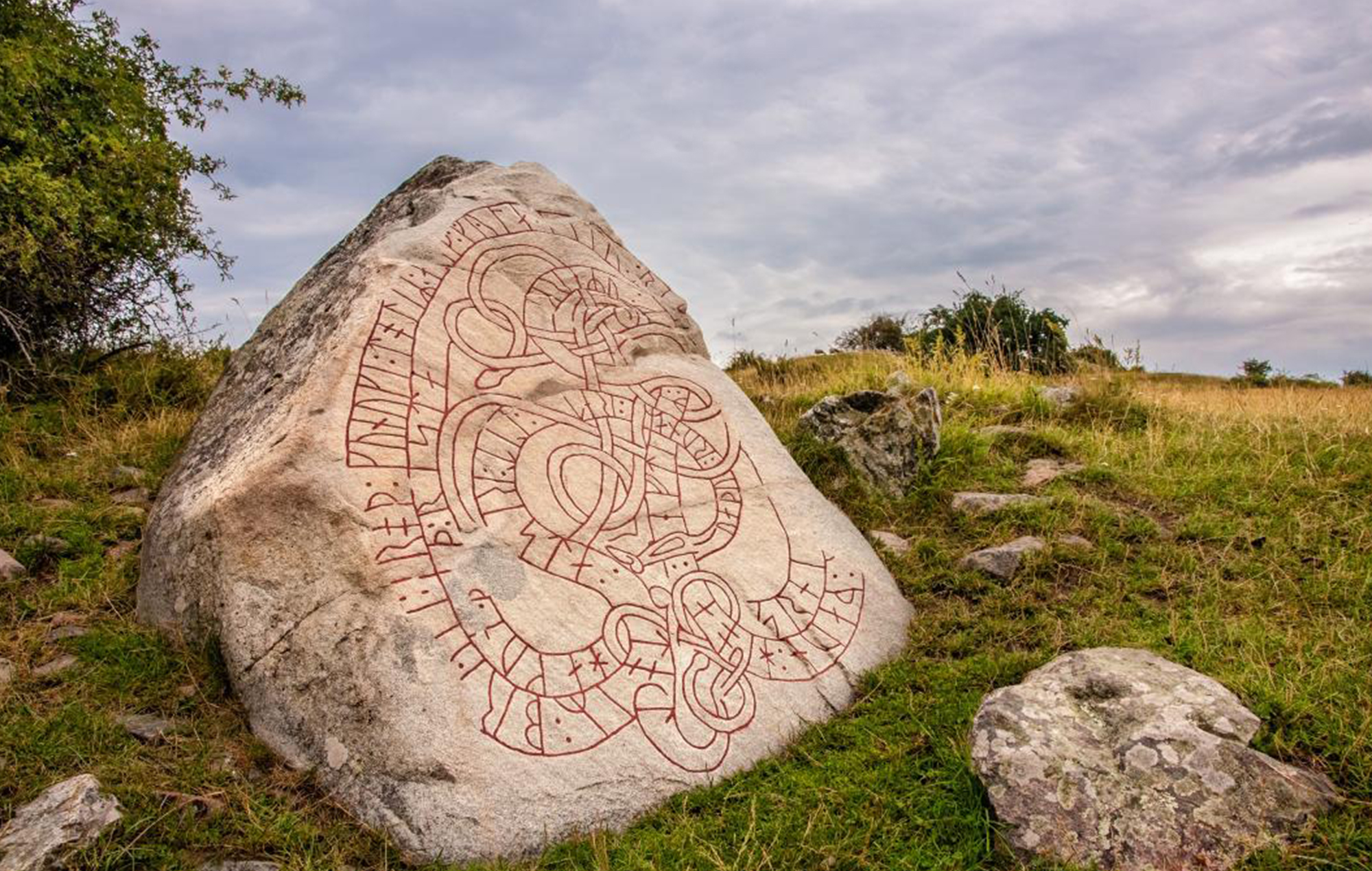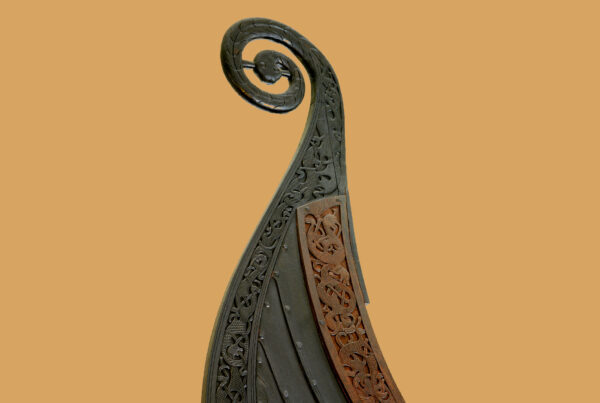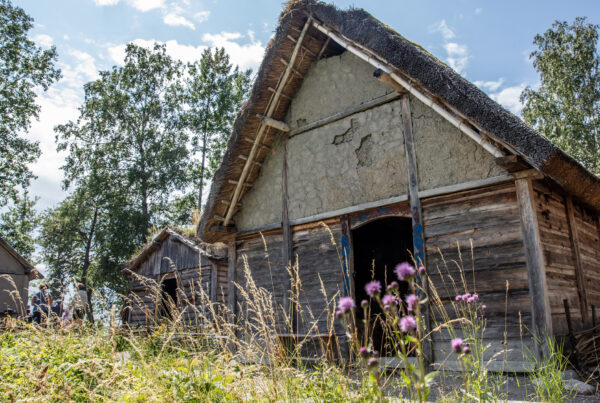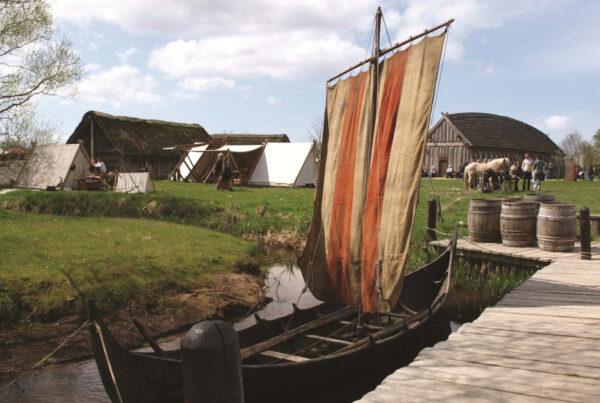Birka, situata sull’isola di Björkö nel Lago Mälaren in Svezia, è considerata uno dei siti archeologici dell’epoca vichinga più importanti della Scandinavia. Tra l’VIII e il X secolo, fu un fiorente centro commerciale e uno dei primi centri urbani della Svezia.
Oggi Birka è inclusa nella Lista del Patrimonio Mondiale dell’UNESCO, in quanto offre una preziosa testimonianza delle dinamiche sociali, economiche e culturali dell’età vichinga. È anche una meta molto visitata, quindi questa guida ha lo scopo di fornire informazioni pratiche su come raggiungere Birka e cosa vedere. È una gita perfetta da fare in giornata da Stoccolma, soprattutto se sei interessato alla storia dei primi vichinghi.
Birka fu fondata intorno al 750 d.C. come porto commerciale da un re o da mercanti che cercavano di controllare i traffici. È uno degli insediamenti urbani più antichi della Scandinavia. Birka fungeva da collegamento baltico nella rotta commerciale del Dnepr, passando per Ladoga e Novgorod fino all’Impero Bizantino e al Califfato Abbaside.
Birka fu anche il sito della prima comunità cristiana conosciuta in Svezia, fondata nell’831 da Sant’Ansgario (Ansgar).
Nel suo periodo di massimo splendore, si stima che vivessero qui circa 1000 persone.
Come centro commerciale, Birka probabilmente esportava pellicce, oggetti in ferro e prodotti artigianali. Le pellicce provenivano dai Sami, dai finlandesi e dalle popolazioni della Russia nord-occidentale, oltre che da cacciatori locali. Le specie includevano orsi, volpi, martore, lontre, castori e altre. Sono documentati anche i commerci di avorio di tricheco, ambra e miele. In cambio, Birka importava materiali da Europa e Asia occidentale. Tra i beni stranieri ritrovati ci sono vetro e oggetti in metallo, ceramiche del Reno, vestiti e tessuti come seta cinese, ricami bizantini e corde intrecciate di alta qualità.
L’insediamento fu abbandonato intorno al 975 d.C., nello stesso periodo in cui venne fondata Sigtuna come città cristiana a circa 35 km a nord-est. In base alla datazione delle monete ritrovate, la città sembra essersi estinta intorno al 960. Le cause del declino di Birka sono oggetto di discussione. L’isola baltica di Gotland era in una posizione migliore per il commercio bizantino e stava diventando un importante centro mercantile. Si è anche ipotizzato che Birka sia stata vittima di un attacco nemico.
Non sono sopravvissuti testi scritti della zona, anche se Adamo di Brema scrisse sull’opera missionaria di Ansgario a Birka e dell’arcivescovo Unni, morto lì nel 936. L’attività di Sant’Ansgario fu il primo tentativo di convertire la popolazione di Birka dalla religione norrena al Cristianesimo.
La posizione esatta di Birka andò persa nel tempo, portando a molte speculazioni tra gli storici svedesi. Alla ricerca di Birka, l’antiquario Johan Hadorph fu il primo a tentare scavi sull’isola nel tardo XVII secolo.
Nel tardo XIX secolo, l’entomologo Hjalmar Stolpe arrivò sull’isola per studiare insetti fossili intrappolati nell’ambra. Scoprì grandi quantità di ambra, insolite per il Lago Mälaren, il che lo portò a ipotizzare un uso commerciale dell’isola. Da qui iniziarono numerosi scavi archeologici. Questi indicarono la presenza di un grande insediamento e portarono a vent’anni di scavi guidati da Stolpe.
I resti archeologici si trovano nella parte nord dell’isola e coprono un’area di circa 7 ettari. Comprendono sepolture e costruzioni, e c’è anche una fortezza collinare chiamata “Borgen”. La tecnica di costruzione degli edifici è ancora sconosciuta, ma il materiale principale era il legno.
Il 15 giugno 2022, è stato annunciato che archeologi del Laboratorio di Ricerca Archeologica dell’Università di Stoccolma avevano trovato un cantiere navale dell’epoca vichinga nel Lago Mälaren.
Birka è un sito importante per diversi motivi:
– Centro commerciale: era un mercato vivace durante il periodo vichingo. Qui si commerciavano pellicce, ferro, ambra e tessuti con regioni lontane come l’Impero Bizantino, il Medio Oriente e l’Europa occidentale.
– Cristianizzazione: fu uno dei primi luoghi in Svezia ad accogliere il Cristianesimo. Fu un punto focale per i missionari cristiani, come Ansgario, nel IX secolo.
– Reperti archeologici: contiene resti di abitazioni vichinghe, tombe e oggetti come gioielli, utensili e armi.
Birka non è l’unico sito vichingo della zona; c’è anche Hovgården sull’isola vicina di Adelsö. Insieme formano un complesso archeologico che illustra le complesse reti commerciali della Scandinavia vichinga e la loro influenza sulla successiva storia europea. Birka e Hovgården sono Patrimonio dell’Umanità dell’UNESCO dal 1993.
La maggior parte dei visitatori raggiunge Birka con un tour guidato da Stoccolma. L’escursione di un giorno comprende una visita guidata a piedi e l’ingresso al museo.
Ecco alcuni punti salienti dell’isola:
-
Museo di Birka: espone reperti e ricostruzioni di edifici dell’epoca vichinga. È importante ricordare che a Birka non si vedrà una città vera, ma rovine e siti scavati. È interessante dal punto di vista archeologico. Non ha la varietà di oggetti che si trova nella sezione vichinga del Museo di Storia Svedese, ma resta comunque una visita piacevole. Modelli e diorami mostrano com’era l’insediamento nel suo periodo d’oro.
-
Ricostruzione di un villaggio vichingo: costruito di fronte al museo, dà un’idea di come poteva apparire Birka tra l’VIII e il X secolo. Ha un’atmosfera autentica e decorazioni basate su ipotesi storiche.
-
Oltre 3.000 tombe (molte ancora da scavare), che mostrano pratiche di sepoltura diverse. Si ritiene che i Danesi attaccarono Birka, portando alla costruzione di una fortezza. È ancora visibile un punto di accesso di un muro difensivo vichingo. In cima alla collina si trova il Monumento ad Ansgar, una croce eretta nel 1834 in suo onore.
-
Le tombe includono cremazioni e sepolture in bara o in camere funerarie. Le analisi scheletriche e i gioielli di genere specifico mostrano che la maggior parte dei defunti era di sesso femminile. Si ipotizza che ciò dipenda dal fatto che i corredi funerari femminili sono più facili da identificare, mentre le tombe maschili senza oggetti sono più difficili da attribuire.
-
Molte tombe contengono oggetti provenienti da paesi stranieri, come monete, vetro e tessuti dal Medio Oriente e dall’Asia orientale.
-
Al museo di Birka si può vedere la Iscrizione Runica Uppland 6, scoperta in più pezzi sull’isola. I 10 frammenti sono stati ricomposti e messi in mostra. Sono stati trovati nell’arco di 100 anni.
-
Il Museo di Storia Svedese ha una delle migliori esposizioni sull’età vichinga in Scandinavia. Contiene molti oggetti da Birka, come pattini da ghiaccio fatti con ossa animali, ciondoli d’argento, collane, perle e perline di vetro. È anche esposto lo scheletro di una bambina, nota come “la Ragazza di Birka”, una rara sepoltura sontuosa di una bambina di sei anni. È esposto anche il controverso “Anello di Allah” di Birka.
Birka, located on the island of Björkö on Lake Mälaren in Sweden, is considered to be one of the most significant Viking Age archaeological sites in Scandinavia. From the 8th to the 10th century, this was a thriving trade hub and one of the earliest urban centres in Sweden.
Today Birka is on the UNESCO World Heritage List as the site provides an insight into the Viking Age’s social, economic and cultural dynamics. It’s also a popular place for visitors, so this guide is designed to give you practical information on how to reach Birka and what you can see there. It’s a perfect day trip from Stockholm, especially if you are interested in early Viking history.
Birka was founded around 750 AD as a trading port by a king or merchants trying to control trade. It is one of the earliest urban settlements in Scandinavia. Birka served as the Baltic link in the Dnieper Trade Route through Ladoga and Novgorod to the Byzantine Empire and the Abbasid Caliphate.
Birka was also the site of the first known Christian congregation in Sweden, founded in 831 by Saint Ansgar.
At its peak, it’s believed that around 1000 people lived here.
As a trading centre, Birka likely exported furs, iron goods, and craft products. Furs were obtained from the Sami people, the Finns, and the people of Northwestern Russia, as well as local trappers. Furs included bear, fox, marten, otter, beaver, and other species. The trade of walrus tusks, amber, and honey is also documented. In return, it imported various materials from Europe and Western Asia. Foreign goods found in Birka include glass and metalware, pottery from Rhineland, clothing and textiles including Chinese silk, Byzantine embroidery, and plaited cords of high quality.
The settlement was abandoned in 975 AD, around the same time that Sigtuna was founded as a Christian town some 35km to the northeast. Based on the dating of coins found in the area, the city seems to have died out around 960. The reason for Birka’s decline are disputed. The Baltic island of Gotland is a better position for the Byzantine trade, and it was gaining eminence as a mercantile stronghold. It has also been speculated that Birka was the victim of an enemy assault.
No texts survive from the area, though Adam of Bremen wrote about the missionary work of Ansgar in Birka as well as the Archbishop Unni, who died at Birka in 936. Saint Ansgar’s work was the first attempt to convert the people of Birka from the Old Norse religion to Christianity.
The exact location of Birka was lost over time, leading to speculation from Swedish historians. In search of Birka, National Antiquarian Johan Hardorph was the first to attempt excavations on the island in the late 17th century.
In the late 19th century, Hjalmar Stolpe, an entomologist, arrived on the island to study fossilised insects found in amber on the island. He found very large amounts of amber, which is unusual as amber is not usually found in Lake Malaren. He speculated that the island must’ve been used for trade, and this began a series of archaeological excavations. These excavations indicated that a major settlement had been located on the island and a two decade excavation, led by Stolpe, took place.
The archaeological remains are located in the northern part of the island and span an area of about 7 hectares (17 acres). The remains are both burial sites and buildings, and there is also a hill fort called “Borgen”. The construction technique of the buildlings is still unknown, but the main material was wood.
On the 15th of June 2022, it was announced that archaeologists from Stockholm University’s Archaeological Research Laboratory had found a Viking Age shipyard in Lake Malaren.
Birka is a significant site for a few reasons:
– Trading Centre: Birka was a bustling marketplace during the Viking period. Here, goods like furs, iron, amber and textiles were traded with regions as far as the Byzantine Empire, the Middle East, and Western Europe
– Christianisation: Birka was one of the first places in Sweden to adopt Christianity. Therefore, Birka was an early focal point for Christian missionaries, such as Ansgar, who attempted to introduce Christianity to Sweden in the 9th century
– Archaeological Finds: The site of Birka contains remains of Viking dwellings, graves, and artifacts such as jewellery, tools, and weapons.
Birka isn’t the only Viking Age site in the area; there is also Hovgården on the neighbouring island of Adelsö. Together, they both make up an archaeological complex which illustrates the elaborate trading networks of Viking Scandinavia and their influence on the subsequent history of Europe. Birka and Hovgården have been a UNESCO World Heritage Site since 1993.
Most visitors come to Birka as part of a guided tour from Stockholm city centre. The full day-trip includes a guided walking tour of the site as well as a visit to the museum. Here are some highlights of the island.
Birka Museum
The Birka Museum displays artifacts and reconstructions of Viking Age buildings. It’s important to keep in mind that you won’t see a real city in Birka. Rather, you see ruins and sites that have been excavated. Birka is interesting from an archaeological perspective. The museum doesn’t have the wide variety of objects like what you’d find in the Vikings section at the Swedish History Museum, but it’s still a nice place to visit. The museum provides insight into what the Viking settlement would have looked like in its heyday through various models and dioramas.
A recreation of a Viking settlement has been built across from the museum so you can get an idea into what Birka may have looked like from the 8th to the 10th centuries. The reconstruction has a nice, authentic vibe to it and is decorated in a way that they believe the Vikings would’ve decorated.
There are over 3,000 graves, many still unexcavated, showing diverse burial practices and goods.
Danes attacked Birka, so it’s believed that a fortress was built to protect the settlement. An entry point in a Viking-era defensive wall still stands at Birka. At the top of the hillfort is the Ansar Monument, a cross erected in 1834 in honour of Saint Ansgar.
Over 3,000 grave sites are located on Birka, including both cremations and burials in coffins or chamber graves. Skeletal analysis and the presence of gender-specific jewellery and objects in graves has shown that the majority of the deceased are female. It’s theorised that this is because female grave goods are easy to identify, but male graves without objects are difficult to identify.
Many graves contain objects such as coins, glass and textiles that came from foreign countries such as Middle East and Eastern Asia.
At the Birka Museum you can see Uppland Runic Inscription 6, which was discovered in several pieces on the island. The 10 pieces have bene placed together and are on display. These fragments were found over a period of 100 years.
The Swedish History Museum has one of the best exhibitions on the Viking Age in Scandinavia. The museum contains many items from Birka. For example, here you can see ice skates made of animal bone, silver pendants, a necklace, pearls, and glass beads. There is also the skeleton of a child known as the “Birka Girl”. This is a rare lavish burial of a six-year-old girl. Birka’s controversial ‘Allah Ring’ is also on display here.
